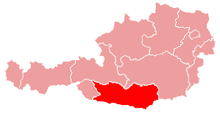Prince-bishop of Gurk
|
Diocese of Gurk-Klagenfurt Dioecesis Gurcensis Diözese Gurk-Klagenfurt Krška škofija |
|
|---|---|

|
|
| Location | |
| Country | |
| Territory | Carinthia |
| Ecclesiastical province | Salzburg |
| Metropolitan | Archdiocese of Salzburg |
| Statistics | |
| Area | 9,533 km2 (3,681 sq mi) |
| Population - Total - Catholics |
(as of 2013) 557,773 387,619 (69.5%) |
| Parishes | 336 |
| Information | |
| Denomination | Roman Catholic |
| Rite | Roman Rite |
| Established | March 6, 1071 |
| Cathedral | Dom Sankt Peter und Paul, Klagenfurt |
| Co-cathedral | Dom Maria Himmelfahrt, Gurk, Carinthia |
| Patron saint |
Saint Hemma John the Baptist |
| Secular priests | 188 (diocesan) 55 (Religious Orders) 49 Permanent Deacons |
| Current leadership | |
| Pope | Francis |
| Bishop | Alois Schwarz |
| Metropolitan Archbishop | Franz Lackner |
| Map | |
 |
|
| Website | |
| Website of the Diocese | |
The Roman Catholic Diocese of Gurk-Klagenfurt (German: Diözese Gurk-Klagenfurt, Slovene: Krška škofija) is a Catholic diocese covering the Austrian state of Carinthia. It is part of the ecclesiastical province of Salzburg. Though named after Gurk Cathedral, the bishop's see since 1787 is in Klagenfurt.
Due to the presence of Carinthian Slovenes, the organizational structures of the diocese are bilingual. The Slovene language is, together with German, the language of church services in 69 southern parishes of the diocese.
In 1072 a suffragan bishopric in the Duchy of Carinthia, subordinate to the Archdiocese of Salzburg, was erected by Archbishop Gebhard of Salzburg, with the authorization of Pope Alexander II (21 March 1070) and Emperor Henry IV (4 February 1072). It could rely on the properties of a former nunnery in Gurk founded by Countess Hemma in 1043. The first bishop installed was the local noble Günther von Krapffeld (1072–1090). The episcopal residence was not in Gurk, but at nearby Strassburg Castle.
Initially the Gurk bishops only held the rights of vicars, while the right of appointment, consecration, and investiture was reserved to the Salzburg archbishop. The diocese served as a model for later Salzburg establishments like the Bishopric of Chiemsee (1216), the Diocese of Seckau, and the Diocese of Lavant (1228). Not until 1123 Archbishop Conrad I of Salzburg founded a cathedral chapter at Gurk, which under Bishop Roman I (1132–1167) obtained the right to elect the bishop. The boundaries of the diocese were only defined in 1131. Originally the territory embraced was small, but the jurisdiction of the Bishop of Gurk extended beyond the limits of his diocese, inasmuch as he was also vicar-general of that part of Carinthia under the Archbishop of Salzburg. The rights of a secular Vogt advocate were held by the Carinthian dukes.
...
Wikipedia
